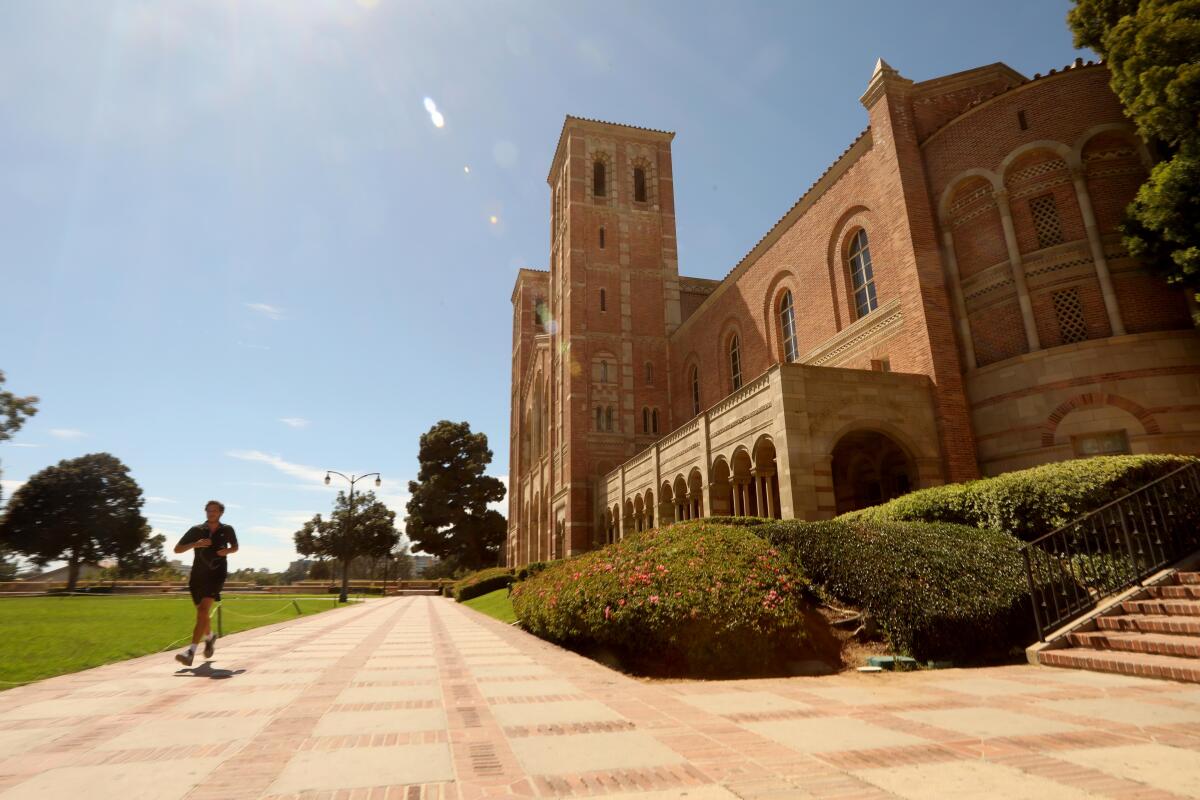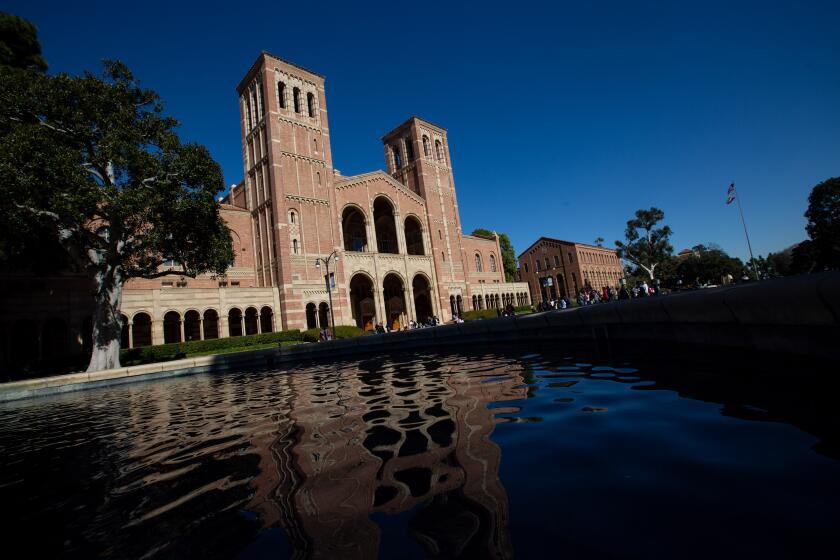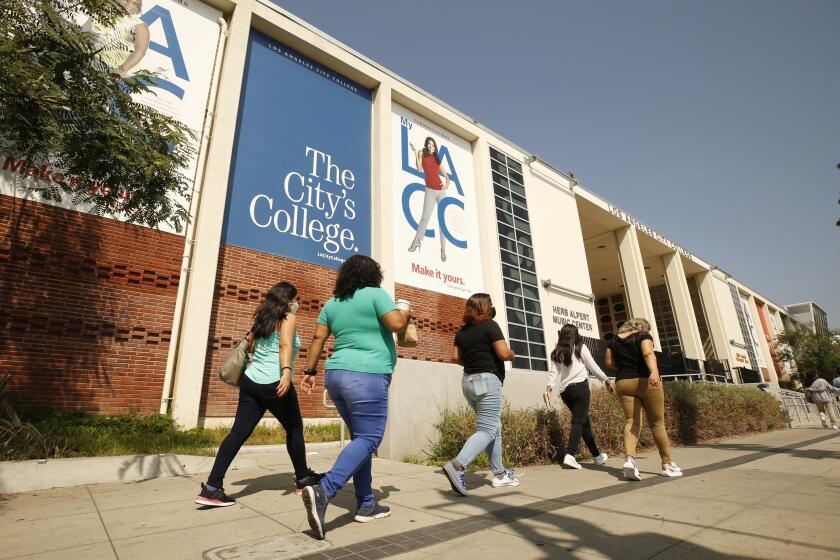Conflict brews over governor’s student transfer guarantee plan for ultracompetitive UCLA

- Share via
For thousands of community college students who vie each year to transfer to ultracompetitive UCLA, it sounds like a dream: Complete required coursework, meet a specified grade-point average and earn guaranteed admission to the most popular university in the nation.
That’s what Gov. Gavin Newsom directed UCLA to do in his proposed budget last month — or risk losing $20 million in state funding. Newsom, along with legislators and many equity advocates, have been pushing the University of California to simplify its transfer process and widen entry to more state students, especially at UCLA, UC Berkeley and UC San Diego, the system’s three most selective campuses.
Newsom’s proposal blindsided UCLA and set off a scramble to understand the governor’s intent. Neither Newsom’s office nor the state Department of Finance responded to a request for comment about the directive, which lacked details such as admission targets. At a state Assembly hearing Tuesday, Jack Zwald of the finance department said the proposal was intended to “increase access and equity” for transfer students to UCLA.
But opposition to it surfaced last week in unexpectedly strong language. The state’s nonpartisan Legislative Analyst’s Office, which provides fiscal and policy advice to legislators, called Newsom’s proposal “particularly myopic,” saying it would set a “very poor policy precedence” by linking state funding to narrow outcomes at a single campus. The Legislature must pass the budget by June 15.
Moreover, the analysis said the proposal “violates the basic tenet of fairness” by potentially punishing one campus when others acting in the same way would not face state repercussions. Among UC’s nine undergraduate campuses, six offer transfer admission guarantee programs. UCLA, UC Berkeley and UC San Diego do not.
The analysis recommended that the Legislature reject the proposal and consider an approach to transfer reforms that would apply to all campuses. At least one key legislator involved in state education policy — Assemblyman Kevin McCarty (D-Sacramento) — also backs a systemwide approach.
The push to admit more Californians comes amid demands to narrow entry to out-of-state and international applicants to free more seats for residents.
“Why single out UCLA? We didn’t get a clear answer” from Newsom’s team, said Jennifer Pacella, deputy legislative analyst who co-authored the review. “UCLA has a good track record in this area. We didn’t see a problem.”
Eloy Ortiz Oakley, president of the nonprofit College Futures Foundation and formerly a California Community Colleges chancellor and UC regent, said he supports Newsom’s pressure on UCLA and the UC system. Oakley — who forged a 2018 agreement with then-UC President Janet Napolitano to improve transfer guarantee paths — said he remains frustrated by the pace of progress.
“I do agree with the governor that he’s got to put an emphasis and strong incentive for UC to move aggressively toward transfer,” Oakley said. “It sends a clear message to [UC President] Michael Drake that he’s got to get his campuses on board.”
In a statement, a university spokesman said that UC leaders shared the commitment by Newsom and the Legislature to provide needed support for state community college students to transfer to UC and thrive. UC will continue to work with state leaders to expand the transfer pipeline, including additional outreach to 65 campuses with high proportions of low-income students, the statement said.
Three-fourths of applicants from state community colleges are admitted to UC, more than half of those enrolled pay no tuition and 89% graduate — a rate slightly higher than those who start as first-year students and significantly higher than the 55% national average, according to UC data. One-third of UC undergraduates are transfer students.
“Providing opportunities for California transfer students remains a top priority for the University, and we will continue partnering with anyone who shares that commitment,” Drake said in a statement to The Times.
UC faculty leaders say they are eager to accommodate more transfer students of diverse backgrounds. But they question whether imposing a transfer guarantee program at UCLA could result in unintended consequences. Students are currently admitted under a comprehensive review process, which includes consideration of their life experiences, neighborhoods and challenges. A transfer guarantee program pegged primarily to grades — which tend to be correlated with family income — could displace students who would have been admitted through the review process.
Such transfer guarantees have traditionally been used to attract students to campuses with enough open seats. But UCLA has an abundance of applicants, said Jim Chalfant, chair of the UC Academic Senate’s special committee on transfer issues.
Last year, UCLA admitted 23% of 24,907 transfer applicants for fall 2022. Although that admission rate is nearly three times higher than the rate for first-year applicants, competition is still fierce. Admitted transfer students had near-perfect grades, with a median GPA of 3.9.
Even so, UCLA expects to enroll the largest number of transfer students among UC campuses this academic year, has the best rate of enrolling transfer students relative to first-year students and graduates them at higher rates than the systemwide average, the legislative analyst’s review said.
“The campus does not show evidence of requiring special rules to promote better transfer access or outcomes,” the analysis said.
Drake reiterated that point at the Assembly budget subcommittee hearing Tuesday. He said UCLA had “perhaps the most successful” transfer student admission process among the system’s nine undergraduate campuses. A greater share of UCLA’s transfer students come from underrepresented racial and ethnic backgrounds than first-year students, while the reverse is true systemwide, he said. Drake added that UCLA builds its diverse transfer class by using the holistic review process.
“We wouldn’t want to have a change that decreased the ability or the access of underrepresented students to UCLA,” Drake said.
The University of California plans to offer conditional admission to students who aren’t eligible as first-year applicants as long as they meet course and grade requirements at a community college.
Among UCLA’s transfer students, about half are low-income, 45% are the first in their families to attend college and one-third represent historically underrepresented racial and ethnic groups. They are overwhelmingly products of California Community Colleges, representing 110 of the system’s 116 campuses. Nearly half, however, were admitted from 10 campuses, including Santa Monica College, Pasadena City College, Los Angeles Pierce College in Woodland Hills, El Camino College in Torrance and Irvine Valley College.
Jessica Cattelino, chair of the UCLA Academic Senate, said the campus was “proud to meet our transfer goals and commitments on a regular basis and consider successful transfer programs and experiences to be core to the academic mission.”
Some equity advocates, however, say UCLA and UC could do a better job.
Michele Siqueiros, president of the Campaign for College Opportunity, said all UC campuses should offer a guaranteed admission path for transfer students as the California State University system does.
Cal State admits all students who earn a two-year community college degree known as Associate Degree for Transfer and meet minimum GPA requirements. The university guarantees admission only to the system, however, not to specific campuses.
Among the six UC campuses with transfer guarantee programs, most omit certain majors from the program due to the high number of applicants for limited seats. UC Davis, for instance, excludes its new major in data science. UC Irvine omits art, business administration, dance, music, nursing science and all majors in the Donald Bren School of Information and Computer Sciences. The Irvine campus does offer the guarantee for other popular majors, such as biological sciences and psychological sciences.
Systemwide, 13,031 of 46,155 prospective transfer students applied for fall 2021 through the guaranteed admission program. In a memo presented to regents last month, UC said its top priorities include doubling the number of students with transfer admission guarantees, increasing those from underrepresented backgrounds and strengthening transfer support services particularly in the Central Valley and Inland Empire.
Oakley and Siqueiros are pushing UC to admit all community college students who earn the Associate Degree for Transfer as Cal State does. Earning that degree guarantees review but not admission at UC.
But UC has indicated it doesn’t favor a “one-size-fits-all approach” across its campuses and with CSU.
“Student transfer in California has been described as a confusing maze of options that is difficult to navigate. This has prompted a push toward transfer streamlining that prioritizes the standardization of transfer options at the expense of the richness of educational opportunities
available to students,” the memo said. “The University prefers to embrace the differences that distinguish areas of emphasis within popular, significant UC disciplines.”
Chalfant, of the UC Academic Senate, said it was “infeasible” to use identical requirements for both systems because of differences in some majors. For instance, UC’s STEM majors typically require more math and science — such as organic chemistry for biology, which is not included in the associate degree for transfer coursework.
Chalfant said he understands the need for a clear path from community college to UC.
“Students just want to know what to do and they’ll do it,” he said. “It’s very reasonable. UC will continue to make improvements.”
More to Read
Sign up for Essential California
The most important California stories and recommendations in your inbox every morning.
You may occasionally receive promotional content from the Los Angeles Times.













